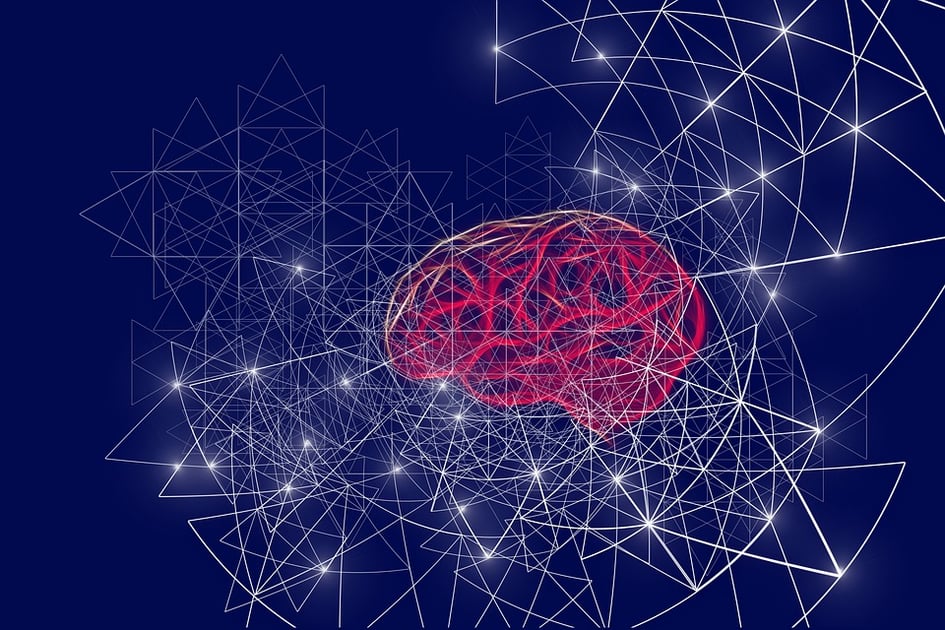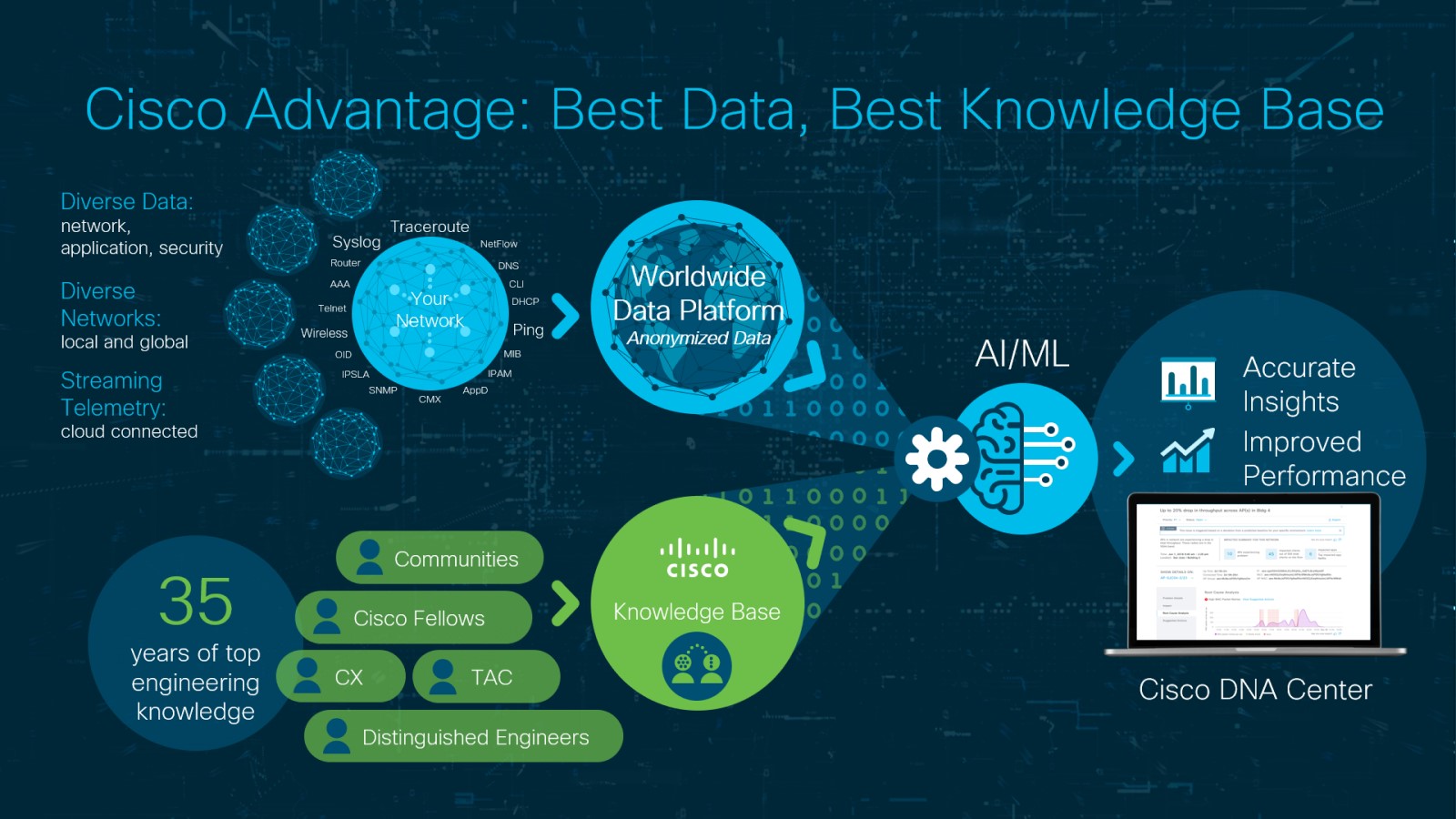Cisco is using AI/ML and data to make Cisco DNA Center smarter! The new Cisco AI Network Analytics solution, within Cisco DNA Center, provides highly personalized information to our customers’ environments that allows them to see problems sooner, solve problems faster and cut out the noise in their network. The computing power for Cisco AI Network Analytics resides both in the Cisco AI Network Analytics cloud (on secure and powerful compute servers) and on premises (within the Cisco DNA Center appliance). Streaming telemetry and other data from network events on the customer’s network are anonymized on site, and then sent to the Cisco cloud, where it is merged with anonymous data from networks around the world. The more networks that are using Cisco AI Network Analytics the more intelligent the system will become. Along with this global data set, we are encapsulating human knowledge; decision-making from Cisco’s best engineers are in this software. All of our best practices and 35 years of networking experience are injected into the decision-making algorithms in the system. Against all this information, we are applying the industry’s most advanced AI/ML algorithms to drive better outcomes. The models are being personalized to local network conditions and prioritized for more relevance, based on your Cisco DNA Center settings. The results are accurate insights leading to improved performance.
Visibility - Personalized baselining
No two networks are the same. AI-driven technologies can learn the user trends, services, and application metrics that are specific to your network. Cisco DNA Assurance can then create a customized performance curve for analytical decisions. The AI-driven baseline for the performance parameters that are unique to your network is constantly adapted as your network grows and changes. From there, the AI-driven analytics engine (both on premises and in the Cisco cloud) can make accurate decisions for what is normal and what is not, based on this personalized baseline. There are a number of features that put this into action, such as:
AI-driven anomaly detection will surface any deviation from our AI-created personalized baseline for this network. This allows Cisco DNA Center to make sense of all the network data. The system can accurately detect performance issues and ignore unusual, but harmless, network anomalies. This reduces noise while accurately identifying anomalies that have the greatest impact on your network. AI-driven predictive analytics and proactive insights allow users to anticipate and prevent failures. Here, the machine learning engine can predict increases in Wi-Fi interference, onboarding delays, office traffic load, etc. This is because, in IP networks, a problematic event is often proceeded by a benign event or series of events. By learning how series of events are correlated to one another, predictive analytics can help network administrators anticipate the unexpected.
There are two categories of proactive insights:
-
System-generated insights appear on the Network Insights menu in Cisco DNA Center. These insights are the most important trends and deviations from the regular performance trends in your network. These insights can help you plan the next steps in growing or planning for network expansion, in order to keep one step ahead of today’s constantly growing network demand.
- Proactive exploration where customers can investigate any part of the network, or service, or application that they want to understand better. An example of proactive exploration is the network heatmap, where a user can compare performance of multiple wireless access points to find opportunities for improvement. Additionally, there are features for site comparison, allowing network administrators to compare different floors in a building or different branch sites. Using the power of anonymized and encrypted data, the user can even compare their network performance with other similar, and anonymous, networks.
Cisco AI Network Analytics provides accelerated remediation through machine learning, which identifies the most critical variables related to the root cause of a given problem. This helps users detect issues and vulnerabilities, perform complex root cause analysis, and execute corrective actions faster than ever. In coming releases, we will enable machine reasoning to execute the logical troubleshooting steps that an engineer would perform in order to resolve a problem. Both of these capabilities accelerate remediation making your team more precise in problem solving and more productive overall.
Customers that turn on the Cisco DNA Center product usage telemetry option can receive additional benefits through the use of a Machine Reasoning Engine (MRE). The MRE can proactively identify potential security issues, improve services and support, verify usage of new features that IT may not be aware of, and assist IT teams with inventory in general. Cisco DNA Center’s MRE can parse through thousands of network devices to verify that all devices have the latest software image and look for potential vulnerabilities in device configuration. If your teams are not taking advantage of the latest upgrade features, it can flag suggestions. Product usage telemetry makes sure your network devices are up to date and your team is getting the most from Cisco DNA Center.
Customers that turn on the Cisco DNA Center product usage telemetry option can receive additional benefits through the use of a Machine Reasoning Engine (MRE). The MRE can proactively identify potential security issues, improve services and support, verify usage of new features that IT may not be aware of, and assist IT teams with inventory in general. Cisco DNA Center’s MRE can parse through thousands of network devices to verify that all devices have the latest software image and look for potential vulnerabilities in device configuration. If your teams are not taking advantage of the latest upgrade features, it can flag suggestions. Product usage telemetry makes sure your network devices are up to date and your team is getting the most from Cisco DNA Center.
Cisco AI Network Analytics is now a standard part of Cisco DNA Center and is included in the Cisco DNA Advantage licensing tier.




